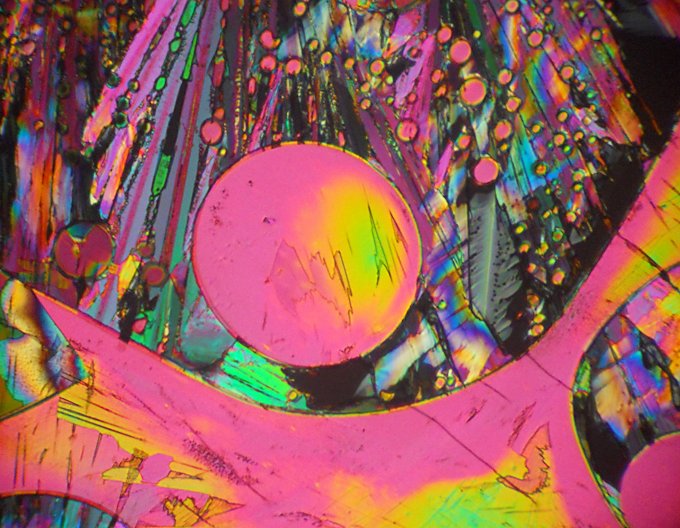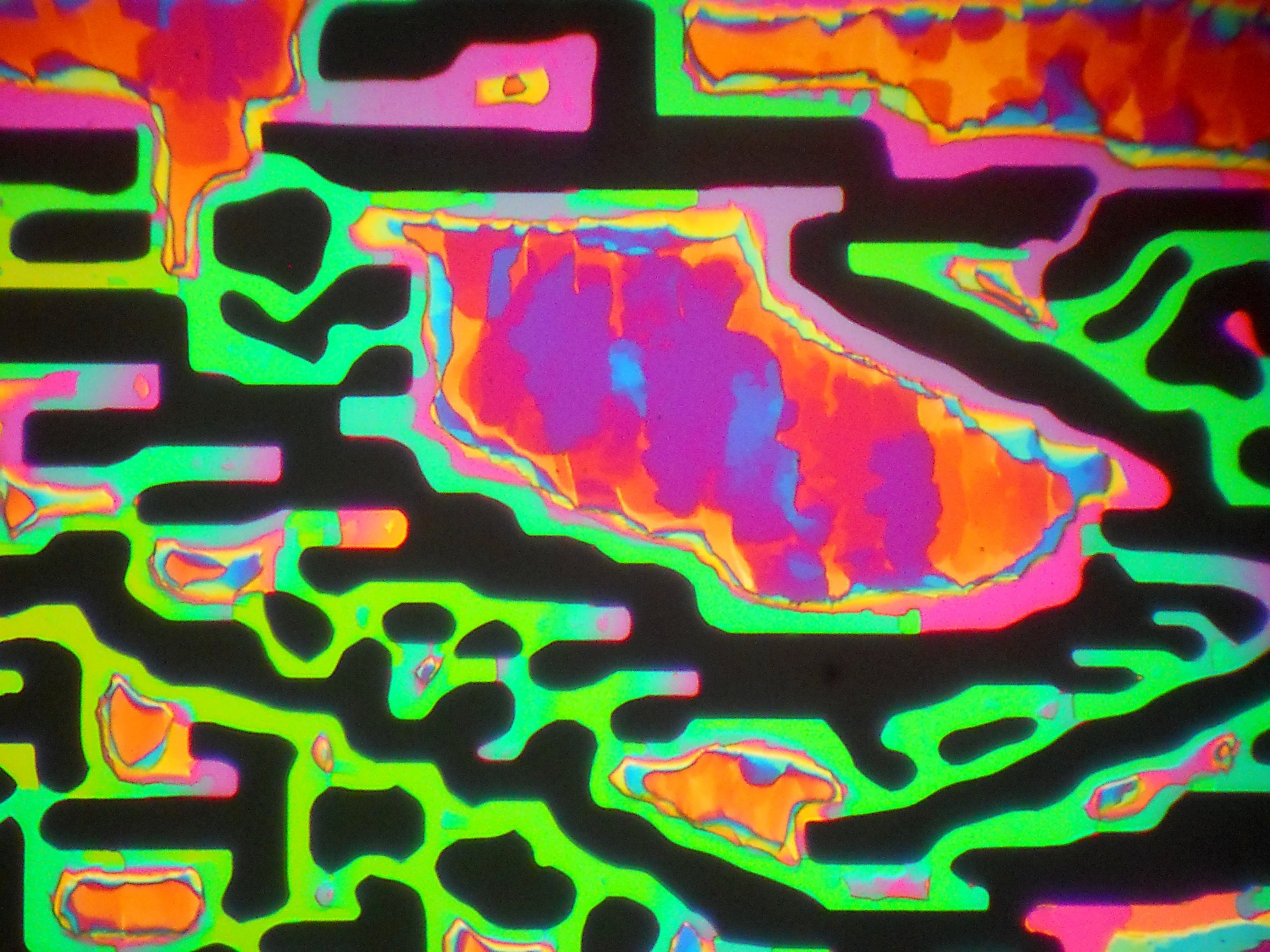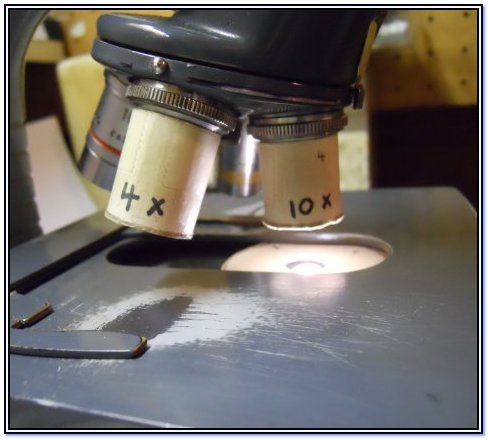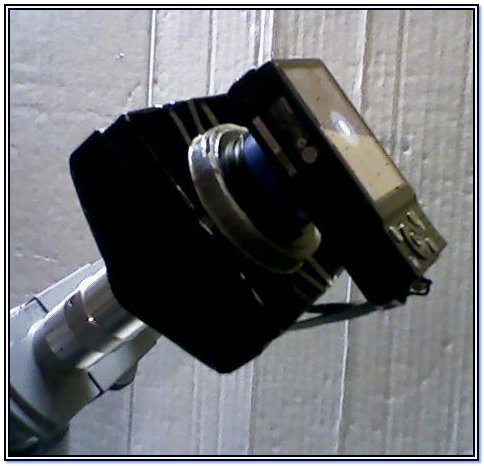
This article features videomicrography of crystal growth captured with an AO binocular microscope
equipped with polarizing filters and a homemade camera mount. When I saw the beauty in the early
footage I decided to put the videos to music. At that point it moved from capturing science videos to
making artistic mood pieces using science as it's base.
The following describes how I started on this path and some of the steps to the finished version.
History: From Kodachromes to Digital ImagesYears ago I pursued the hobby of film photomicrography and had taken many Kodachrome slide images
of crystals under polarized light. My equipment was an old AO clinical binocular microscope with a homemade
mount for my Minolta SLR film camera. The polarizing filters were positioned with hand made friction fit mounts.
Below is a recent still image I captured with the digital setup shown above.
The ease of digital color saturation and contrast control should bring a happy tear to most Cibachrome fans like me.
Xylitol crystals:

In my Kodachrome days I had often seen crystals growing but the thought of capturing that on my 8mm film movie camera seemed like too much of a hassle. ..........................Fast forward to my current digital camera............ : I was watching sulfur crystals grow while waiting for the slide to cool for photos when it occured to me that the Nikon CoolPix has video capability! The camera does not have a removeable lense. I am able to avoid almost all vignetting by using the optical zoom feature. A small amount of extra zoom using the digital zoom feature removes the remaining vignetting and can be used to control cropping composition at the time of video capture. I found my first sulfur movie footage very moving and felt it really needed music to go with it. More about that first video later, let's watch the final version:
Be sure to have your sound on for the accompanying music:
"Microscopic" by Gas. Video of re-crystallizing Para-dichlorobenzene (Mothballs)
and DiMethyl-sulfoxide (DMSO) Set to music "Microscopic" by Gas http://microscopics.co.uk The direct link to the YouTube page is: http://youtu.be/Iw734z1e6wQ
The Music ChoiceWhen I first captured sulfur crystals growing I knew I needed to set the video to music. But what song? What style? Years before I had an experience where I was driving at night on a long empty stretch of highway under a dark and star filled sky. On the radio was a station playing what I would call ambient space music. I recall feeling as if I was driving a starship through a tour of the Milky Way. I didn't want the drive or the music set to end.Years later watching these "other worldly" crystals I knew I wanted that style of music. I was unfamiliar with songs or artists of that venue so started a web-search for clips of music. There were several nice sounding ambient choices but one clip had a sound that really fit my taste for the microscopic crystals. It was then that I noticed the title of the song, "Microscopic" by Gas. How perfect was that ! The music track is available as a free download at: http://www.microscopics.co.uk/music/gas-microscopic.mp3 Though this track is free I wanted the musician Mat Jarvis to see the video and confirm that it was OK to put on YouTube. Fortunately Mat not only liked the video, he also has video experience and provided many video pointers for me (a video newbie) via email. The final video shown above has many improvements over my earlier versions. Mat's constructive tips and perspectives provided the help I needed to progress on my learning curve. Now back to the early footage: The Early ClipsThe first footage was of melted sulfur recrystallizing. I moved the slide by hand so as to follow the most promising crystal front in whatever direction it might go. While I was very happy that I could capture anything at all the following clip does show some of the challenges with this approach. The video is set to unlisted on YouTube so it does not come up on searches but is available to the readers of this article for the points made here:While this was a good start and has many interesting sections, it suffers from jerky tracking, crystals that sometimes grow too fast to track well, and too much use, on my part, with video special effects (FX) to do transitions. So the question became how to address these shortcomings to obtain improved videos. Some of the solutions I applied fall under the next four categories. The first step to more control was the choice of chemical as discussed below. I hope to address some of the others in a future article. Improving Clips by Choice of Chemicals:Sulfur has a variety of interesting forms that are great for still shots. However for capturing video it can often crystallize too fast. An expensive solution would be a heat controlled stage. For a scope without that feature the next best choice for video is to choose a chemical that crystallizes slower. I settled on para-dichlorobenzene. However it did not provide the variety of crystal forms I wanted to see.The solution (pun intended) came in the form of DMSO. Adding trace amounts of DMSO provided the added variety while still maintaining a reasonable melting recrystallizing temperature. My theory of why the crystal forms vary more is that different areas of the slide have gradients in the concentrations of the two chemicals. It is interesting to note that DMSO by itself can be used for crystallization provided the stage is equipped with a chiller or one waits for a sufficiently cold day to do the work. Last winter I did just that. I waited for a day when the garage was very cold. The chemical slide prep is predominantly DMSO. I was able to melt, crystallize, and remelt the prep simply by moving a warm object near the slide and removing it to re-grow the crystals. This approach allowed me to capture longer single video clips as the cycling of crystallize/remelt occurs in the same area of the slide. The longest single video clip in the following video is over 12 minutes long, From 0:21 to 12:43 I call the video "Crystals-Freeze-Thaw-Stretched"
Improving Clips by Control of Temperature:.......... Topic for a future article.Improving Clips with Smoother Stage Motion:.......... Topic for a future article.Improving Clips with Video Editing Tools:.......... Topic for a future article.Audio Clips: Make Some SoundIf you view some of my other YouTube crystal videos, such as the "Crystals-Freeze-Thaw-Stretched" video above, you will hear some sound tracks that I generated with some online sound tools. The main tool is called Paul's Extreme Sound Stretch, hence the "Stretched" in the video title. This software tool can be found at: http://hypermammut.sourceforge.net/paulstretch/Check it out and support freeware authors. |
Have fun and enjoy
For questions contact the author, Dustin Brown, at:
brodwcjj "at" integrity "dot" com


